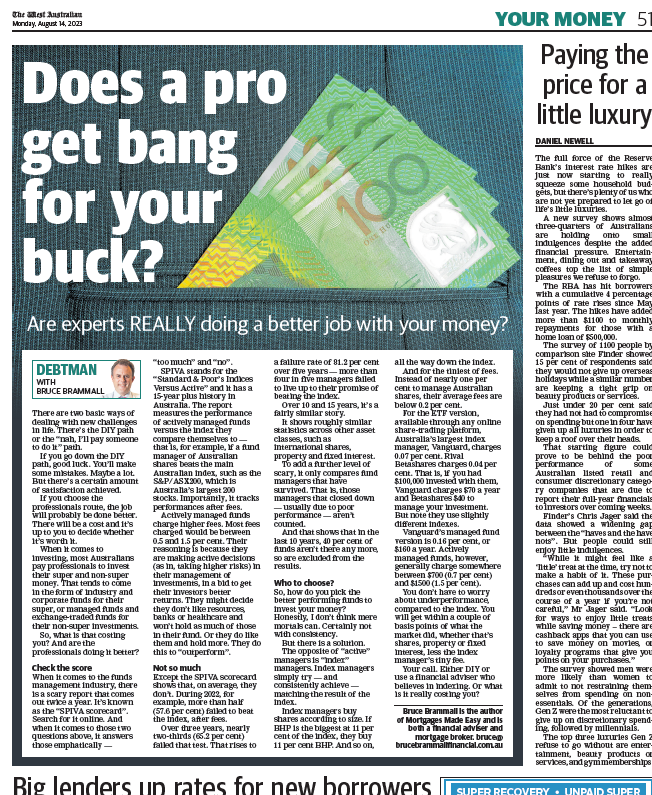
Bruce Brammall, The West Australian, 14 August, 2023
There are two basic ways of dealing with new challenges in life. There’s the DIY path, or the “nah, I’ll pay someone to do it” path.
If you go down the DIY path, good luck. You’ll make some mistakes. Maybe a lot. But there’s a certain amount of satisfaction achieved.
If you choose the professionals route, the job will probably be done better. There will be a cost and it is up to you to decide whether it’s worth it.
When it comes to investing, most Australians pay professionals to invest their super and non-super money.
That tends to come in the form of industry and corporate funds for their super, or managed funds and exchange-traded funds for their non-super investments.
So, what is that costing you? And are the professionals doing it better?
Check the score
When it comes to the funds management industry, there is a scary report that comes out twice a year.
It’s known as the “SPIVA scorecard” (search online). And when it comes to those two questions above, it answers those emphatically – “too much” and “no”.
SPIVA stands for the “Standard & Poor’s Index Versus Active” and it has a 15-year plus history in Australia. The report measures the performance of actively managed funds, versus the index they compare themselves to.
That is, for example, if a fund manager of Australian shares beats the main Australian index, such as the S&P200, which is is Australia’s largest 200 stocks.
Importantly, it tracks performances after fees.
Actively managed funds charge higher fees. Most fees charged would be between 0.5 to 1.5 per cent.
Their reasoning is because they are making active decisions (ie, taking higher risks) in their management of investments, in a bid to get their investors better returns.
They might decide they don’t like resources, banks, or healthcare and won’t hold as much of those in their fund. Or they do like them, and hold more.
They do this to “outperform”.
Not so much
Except the SPIVA scorecard shows that, on average, they don’t.
During 2022, for example, over half (57.6 per cent) failed to beat the index, after fees.
Over three years, nearly two-thirds (65.2 per cent) failed that test. That rises to a failure rate of 81.2 per cent over five years – more than four in five managers failed to live up to their promise of beating the index.
Over 10 and 15 years, it’s a fairly similar story.
It shows roughly similar statistics across other asset classes, such as international shares, property and fixed interest.
To add a further level of scary, it only compares fund managers that have survived. That is, those managers that closed down (usually due to poor performance) aren’t counted.
And that shows that in the last 10 years, 40 per cent of funds aren’t there anymore, so are excluded from the results.
Who to choose?
So, how do you pick the better performing funds to invest your money?
Honestly, I don’t think mere mortals can. Certainly not with consistency.
But there is a solution.
The opposite of “active” managers is “index” managers. Index managers simply try (and consistently achieve) matching the result of the index.
Index managers simply buy shares according to size. If BHP is the biggest at 11 per of the index, they buy 11 per cent BHP. And so on, all the way down the index.
And for the tiniest of fees. Instead of nearly 1 per cent to manage Australian shares, their average fees are below 0.2 per cent.
For the ETF version, available through any online share trading platform, Australia’s largest index manager, Vanguard, charges 0.07 per cent. Rival Betashares charges 0.04 per cent.
That is, if you had $100,000 invested with them, Vanguard charges $70 a year and Betashares $40 to manage your investment. (Note: They use slightly different indexes.)
Vanguard’s managed fund version is 0.16 per cent, or $160 a year. Actively managed funds, however, generally charge somewhere between $700 (0.7 per cent) and $1500 (1.5 per cent).
You don’t have to worry about underperformance, compared to the index. You will get within a couple of basis points of what the market did, whether that’s shares, property or fixed interest, less the index manager’s tiny fee.
Your call. Either DIY or use a financial adviser who believes in indexing. Or what is it really costing you?
Bruce Brammall is the author of Mortgages Made Easy and is both a financial adviser and mortgage broker. E: bruce@brucebrammallfinancial.com.au.